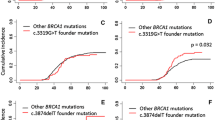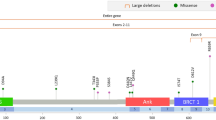Abstract
Germ-line mutations in the tumour suppressor proteins BRCA1 and BRCA2 predispose to breast and ovarian cancer. We examined 32 breast and/or ovarian cancer patients from Greenland for mutations in BRCA1 and BRCA2. Whereas no mutations were identified in 19 families, 13 families exhibited a BRCA1 exon 3 nucleotide 234 T > G mutation, which has not previously been reported in the breast cancer information core (BIC) database. The mutation changes a conserved cysteine 39 to a glycine in the Zn2+ site II of the RING domain, which is essential for BRCA1 ubiquitin ligase activity. Eight of the families had members with ovarian cancer, suggesting that the RING domain may be an ovarian cancer hotspot. By SNP array analysis, we find that all 13 families share a 4.5 Mb genomic fragment containing the BRCA1 gene, showing that the mutation originates from a founder. Finally, analysis of 1152 Inuit, representing almost ~2% of the total Greenlandic Inuit population, showed that the frequency of the mutation was 1.0%. We conclude that the BRCA1 nucleotide 234 T > G is a common Greenlandic Inuit founder mutation. The relative high frequency in the general population, together with the ease of screening and possibility to reduce mortality in gene carriers, may warrant screening of the Greenlandic Inuit population. Provided screening is efficient, about 5% of breast- and 13% of ovarian cancers, respectively, may be prevented.





Similar content being viewed by others
References
Thompson D, Easton D (2004) The genetic epidemiology of breast cancer genes. J Mammary Gland Biol Neoplasia 9(3):221–236. doi:10.1023/B:JOMG.0000048770.90334.3b
Jasin M (2002) Homologous repair of DNA damage and tumorigenesis: the BRCA connection. Oncogene 21(58):8981–8993. doi:10.1038/sj.onc.1206176
Venkitaraman AR (2002) Cancer susceptibility and the functions of BRCA1 and BRCA2. Cell 108(2):171–182. doi:10.1016/S0092-8674(02)00615-3
Davies AA, Masson JY, McIlwraith MJ, Stasiak AZ, Stasiak A, Venkitaraman AR et al (2001) Role of BRCA2 in control of the RAD51 recombination and DNA repair protein. Mol Cell 7(2):273–282. doi:10.1016/S1097-2765(01)00175-7
Moynahan ME, Pierce AJ, Jasin M (2001) BRCA2 is required for homology-directed repair of chromosomal breaks. Mol Cell 7(2):263–272. doi:10.1016/S1097-2765(01)00174-5
Shin S, Verma IM (2003) BRCA2 cooperates with histone acetyltransferases in androgen receptor-mediated transcription. Proc Natl Acad Sci USA 100(12):7201–7206. doi:10.1073/pnas.1132020100
Marmorstein LY, Kinev AV, Chan GK, Bochar DA, Beniya H, Epstein JA et al (2001) A human BRCA2 complex containing a structural DNA binding component influences cell cycle progression. Cell 104(2):247–257. doi:10.1016/S0092-8674(01)00209-4
Bochar DA, Wang L, Beniya H, Kinev A, Xue Y, Lane WS et al (2000) BRCA1 is associated with a human SWI/SNF-related complex: linking chromatin remodeling to breast cancer. Cell 102(2):257–265. doi:10.1016/S0092-8674(00)00030-1
Morris JR, Solomon E (2004) BRCA1: BARD1 induces the formation of conjugated ubiquitin structures, dependent on K6 of ubiquitin, in cells during DNA replication and repair. Hum Mol Genet 13(8):807–817. doi:10.1093/hmg/ddh095
Brzovic PS, Meza J, King MC, Klevit RE (1998) The cancer-predisposing mutation C61G disrupts homodimer formation in the NH2-terminal BRCA1 RING finger domain. J Biol Chem 273(14):7795–7799. doi:10.1074/jbc.273.14.7795
Glover JN (2006) Insights into the molecular basis of human hereditary breast cancer from studies of the BRCA1 BRCT domain. Fam Cancer 5(1):89–93. doi:10.1007/s10689-005-2579-z
Glover JN, Williams RS, Lee MS (2004) Interactions between BRCT repeats and phosphoproteins: tangled up in two. Trends Biochem Sci 29(11):579–585. doi:10.1016/j.tibs.2004.09.010
Borden KL, Freemont PS (1996) The RING finger domain: a recent example of a sequence-structure family. Curr Opin Struct Biol 6(3):395–401. doi:10.1016/S0959-440X(96)80060-1
Brzovic RE, Meza PS, King JE, Klevit MC (2001) BRCA1 RING domain cancer-predisposing mutations. Structural consequences and effects on protein-protein interactions. J Biol Chem 276(44):41399–41406. doi:10.1074/jbc.M106551200
Brzovic PS, Rajagopal P, Hoyt DW, King MC, Klevit RE (2001) Structure of a BRCA1-BARD1 heterodimeric RING-RING complex. Nat Struct Biol 8(10):833–837. doi:10.1038/nsb1001-833
Meza JE, Brzovic PS, King MC, Klevit RE (1999) Mapping the functional domains of BRCA1. Interaction of the ring finger domains of BRCA1 and BARD1. J Biol Chem 274(9):5659–5665. doi:10.1074/jbc.274.9.5659
Wu LC, Wang ZW, Tsan JT, Spillman MA, Phung A, Xu XL et al (1996) Identification of a RING protein that can interact in vivo with the BRCA1 gene product. Nat Genet 14(4):430–440. doi:10.1038/ng1296-430
Jin Y, Xu XL, Yang MC, Wei F, Ayi TC, Bowcock AM et al (1997) Cell cycle-dependent colocalization of BARD1 and BRCA1 proteins in discrete nuclear domains. Proc Natl Acad Sci USA 94(22):12075–12080. doi:10.1073/pnas.94.22.12075
Scully R, Chen J, Ochs RL, Keegan K, Hoekstra M, Feunteun J et al (1997) Dynamic changes of BRCA1 subnuclear location and phosphorylation state are initiated by DNA damage. Cell 90(3):425–435. doi:10.1016/S0092-8674(00)80503-6
Joukov V, Chen J, Fox EA, Green JB, Livingston DM (2001) Functional communication between endogenous BRCA1 and its partner, BARD1, during Xenopus laevis development. Proc Natl Acad Sci USA 98(21):12078–12083. doi:10.1073/pnas.211427098
Chen A, Kleiman FE, Manley JL, Ouchi T, Pan ZQ (2002) Autoubiquitination of the BRCA1*BARD1 RING ubiquitin ligase. J Biol Chem 277(24):22085–22092. doi:10.1074/jbc.M201252200
Hashizume R, Fukuda M, Maeda I, Nishikawa H, Oyake D, Yabuki Y et al (2001) The RING heterodimer BRCA1-BARD1 is a ubiquitin ligase inactivated by a breast cancer-derived mutation. J Biol Chem 276(18):14537–14540. doi:10.1074/jbc.C000881200
Lorick KL, Jensen JP, Fang S, Ong AM, Hatakeyama S, Weissman AM (1999) RING fingers mediate ubiquitin-conjugating enzyme (E2)-dependent ubiquitination. Proc Natl Acad Sci USA 96(20):11364–11369. doi:10.1073/pnas.96.20.11364
Ruffner H, Joazeiro CA, Hemmati D, Hunter T, Verma IM (2001) Cancer-predisposing mutations within the RING domain of BRCA1: loss of ubiquitin protein ligase activity and protection from radiation hypersensitivity. Proc Natl Acad Sci USA 98(9):5134–5139. doi:10.1073/pnas.081068398
Kim H, Chen J, Yu X (2007) Ubiquitin-binding protein RAP80 mediates BRCA1-dependent DNA damage response. Science 316(5828):1202–1205. doi:10.1126/science.1139621
Liu Z, Wu J, Yu X (2007) CCDC98 targets BRCA1 to DNA damage sites. Nat Struct Mol Biol 14(8):716–720. doi:10.1038/nsmb1279
Sobhian B, Shao G, Lilli DR, Culhane AC, Moreau LA, Xia B et al (2007) RAP80 targets BRCA1 to specific ubiquitin structures at DNA damage sites. Science 316(5828):1198–1202. doi:10.1126/science.1139516
Wang B, Elledge SJ (2007) Ubc13/Rnf8 ubiquitin ligases control foci formation of the Rap80/Abraxas/Brca1/Brcc36 complex in response to DNA damage. Proc Natl Acad Sci USA 104(52):20759–20763. doi:10.1073/pnas.0710061104
Wang B, Matsuoka S, Ballif BA, Zhang D, Smogorzewska A, Gygi SP et al (2007) Abraxas and RAP80 form a BRCA1 protein complex required for the DNA damage response. Science 316(5828):1194–1198. doi:10.1126/science.1139476
Eakin CM, Maccoss MJ, Finney GL, Klevit RE (2007) Estrogen receptor alpha is a putative substrate for the BRCA1 ubiquitin ligase. Proc Natl Acad Sci USA 104(14):5794–5799. doi:10.1073/pnas.0610887104
Mallery DL, Vandenberg CJ, Hiom K (2002) Activation of the E3 ligase function of the BRCA1/BARD1 complex by polyubiquitin chains. EMBO J 21(24):6755–6762. doi:10.1093/emboj/cdf691
Starita LM, Horwitz AA, Keogh MC, Ishioka C, Parvin JD, Chiba N (2005) BRCA1/BARD1 ubiquitinate phosphorylated RNA polymerase II. J Biol Chem 280(26):24498–24505. doi:10.1074/jbc.M414020200
Starita LM, Machida Y, Sankaran S, Elias JE, Griffin K, Schlegel BP et al (2004) BRCA1-dependent ubiquitination of gamma-tubulin regulates centrosome number. Mol Cell Biol 24(19):8457–8466. doi:10.1128/MCB.24.19.8457-8466.2004
Wu W, Nishikawa H, Hayami R, Sato K, Honda A, Aratani S et al (2007) BRCA1 ubiquitinates RPB8 in response to DNA damage. Cancer Res 67(3):951–958. doi:10.1158/0008-5472.CAN-06-3187
Yu X, Fu S, Lai M, Baer R, Chen J (2006) BRCA1 ubiquitinates its phosphorylation-dependent binding partner CtIP. Genes Dev 20(13):1721–1726. doi:10.1101/gad.1431006
Morris JR, Pangon L, Boutell C, Katagiri T, Keep NH, Solomon E (2006) Genetic analysis of BRCA1 ubiquitin ligase activity and its relationship to breast cancer susceptibility. Hum Mol Genet 15(4):599–606. doi:10.1093/hmg/ddi476
Bjerregaard P, Curtis T, Borch-Johnsen K, Mulvad G, Becker U, Andersen S et al (2003) Inuit health in Greenland: a population survey of life style and disease in Greenland and among Inuit living in Denmark. Int J Circumpolar Health 62(Suppl 1):3–79
Knudson AG Jr (1971) Mutation and cancer: statistical study of retinoblastoma. Proc Natl Acad Sci USA 68(4):820–823. doi:10.1073/pnas.68.4.820
Friborg J, Koch A, Wohlfarht J, Storm HH, Melbye M (2003) Cancer in Greenlandic Inuit 1973–1997: a cohort study. Int J Cancer 107(6):1017–1022. doi:10.1002/ijc.11502
Abkevich V, Zharkikh A, Deffenbaugh AM, Frank D, Chen Y, Shattuck D et al (2004) Analysis of missense variation in human BRCA1 in the context of interspecific sequence variation. J Med Genet 41(7):492–507. doi:10.1136/jmg.2003.015867
Brzovic PS, Keeffe JR, Nishikawa H, Miyamoto K, Fox D 3rd, Fukuda M et al (2003) Binding and recognition in the assembly of an active BRCA1/BARD1 ubiquitin-ligase complex. Proc Natl Acad Sci USA 100(10):5646–5651. doi:10.1073/pnas.0836054100
Gayther SA, Warren W, Mazoyer S, Russell PA, Harrington PA, Chiano M et al (1995) Germline mutations of the BRCA1 gene in breast and ovarian cancer families provide evidence for a genotype-phenotype correlation. Nat Genet 11(4):428–433. doi:10.1038/ng1295-428
Holt JT, Thompson ME, Szabo C, Robinson-Benion C, Arteaga CL, King MC et al (1996) Growth retardation and tumour inhibition by BRCA1. Nat Genet 12(3):298–302. doi:10.1038/ng0396-298
Thompson D, Easton D (2002) Variation in BRCA1 cancer risks by mutation position. Cancer Epidemiol Biomarkers Prev 11(4):329–336
Gayther SA, Mangion J, Russell P, Seal S, Barfoot R, Ponder BA et al (1997) Variation of risks of breast and ovarian cancer associated with different germline mutations of the BRCA2 gene. Nat Genet 15(1):103–105. doi:10.1038/ng0197-103
Bergman A, Einbeigi Z, Olofsson U, Taib Z, Wallgren A, Karlsson P et al (2001) The western Swedish BRCA1 founder mutation 3171ins5; a 3.7 cM conserved haplotype of today is a reminiscence of a 1500-year-old mutation. Eur J Hum Genet 9(10):787–793. doi:10.1038/sj.ejhg.5200704
Dorum A, Hovig E, Trope C, Inganas M, Moller P (1999) Three per cent of Norwegian ovarian cancers are caused by BRCA1 1675delA or 1135insA. Eur J Cancer 35(5):779–781. doi:10.1016/S0959-8049(99)00050-7
Simard J, Tonin P, Durocher F, Morgan K, Rommens J, Gingras S et al (1994) Common origins of BRCA1 mutations in Canadian breast and ovarian cancer families. Nat Genet 8(4):392–398. doi:10.1038/ng1294-392
Thorlacius S, Olafsdottir G, Tryggvadottir L, Neuhausen S, Jonasson JG, Tavtigian SV et al (1996) A single BRCA2 mutation in male and female breast cancer families from Iceland with varied cancer phenotypes. Nat Genet 13(1):117–119. doi:10.1038/ng0596-117
Helgason A, Palsson G, Pedersen HS, Angulalik E, Gunnarsdottir ED, Yngvadottir B et al (2006) mtDNA variation in Inuit populations of Greenland and Canada: migration history and population structure. Am J Phys Anthropol 130(1):123–134. doi:10.1002/ajpa.20313
Thorlacius S, Sigurdsson S, Bjarnadottir H, Olafsdottir G, Jonasson JG, Tryggvadottir L et al (1997) Study of a single BRCA2 mutation with high carrier frequency in a small population. Am J Hum Genet 60(5):1079–1084
Roa BB, Boyd AA, Volcik K, Richards CS (1996) Ashkenazi Jewish population frequencies for common mutations in BRCA1 and BRCA2. Nat Genet 14(2):185–187. doi:10.1038/ng1096-185
Struewing JP, Abeliovich D, Peretz T, Avishai N, Kaback MM, Collins FS et al (1995) The carrier frequency of the BRCA1 185delAG mutation is approximately 1 percent in Ashkenazi Jewish individuals. Nat Genet 11(2):198–200. doi:10.1038/ng1095-198
Acknowledgements
Nina Ilsøe, Bettina M. Andersen, Karina Nørgaard and Lis Krüger are acknowledged for excellent technical assistance. This study was supported by the Neye Foundation.
Author information
Authors and Affiliations
Corresponding author
Electronic supplementary material
Below is the link to the electronic supplementary material.
Rights and permissions
About this article
Cite this article
Hansen, T.v.O., Ejlertsen, B., Albrechtsen, A. et al. A common Greenlandic Inuit BRCA1 RING domain founder mutation. Breast Cancer Res Treat 115, 69–76 (2009). https://doi.org/10.1007/s10549-008-0060-z
Received:
Accepted:
Published:
Issue Date:
DOI: https://doi.org/10.1007/s10549-008-0060-z




